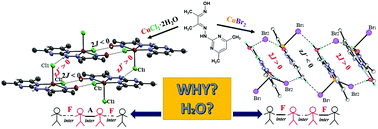Unprecedented interplay of antiferro- and ferromagnetic exchange interactions through intermolecular hydrogen bonds in mononuclear Cu(ii) complexes†
Abstract
Copper(II) coordination compounds with the condensation products of diacetylmonoxime and 2-hydrazino-4,6-dimethylpirimidine (H2L) with the compositions of [Cu(H2L)Br2]·H2O (I) and [Cu(H2L)Cl2] (II) were synthesized. The molecular structures of the compounds were established with the help of a single-crystal X-ray diffraction study. In the case of (I), H2O molecules facilitated the formation of an infinite intermolecular hydrogen bonding (HB) network, leading to ferromagnetic-type exchange interactions between the copper(II) ions of mononuclear coordination units and antiferromagnetic molecular field (2J = +5.53 cm−1, zJ′ = −0.53 cm−1). At the same time in (II) –(O–H)oxime⋯Cl centrosymmetric hydrogen-bonded dimers were formed from mononuclear coordination units, resulting in the presence of antiferromagnetic exchange interactions between the Cu(II) centres and molecular field interactions of the ferromagnetic type (2J = −2.21 cm−1, zJ′ = +0.63 cm−1). DFT-BS calculations were employed to clarify the nature of the pairwise exchange interactions in the crystals of (I) and (II), and to calculate the exchange interaction parameters for several supramolecular dimers, modelling the possible superexchange pathways in the crystalline structures of I and II. In both compounds, intermolecular HBs gave rise to weak magnetic exchange interactions of both the ferro- and antiferromagnetic types.



 Please wait while we load your content...
Please wait while we load your content...